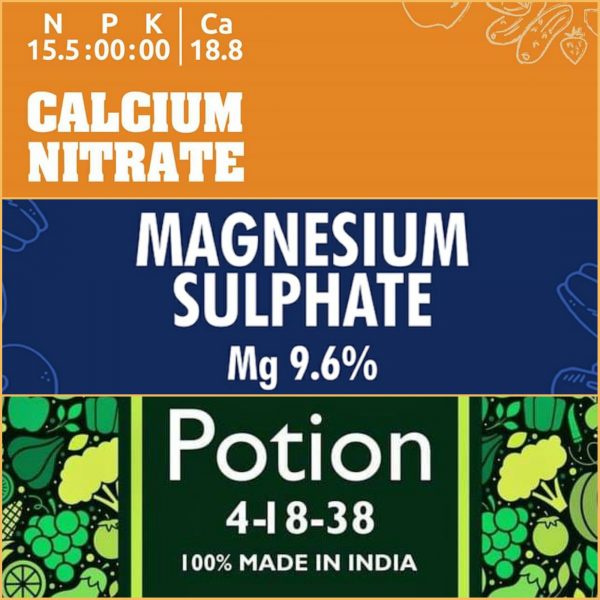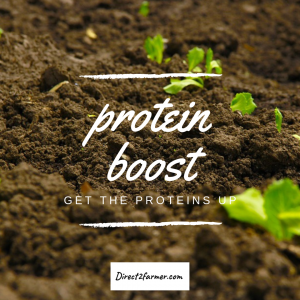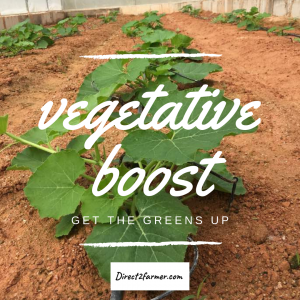₹1,450.00
Hydroponics Combo
Description
Combo Contents :
1. Calcium Nitrate – 1 kg
2. Magnesium Sulphate – 1 kg
3. Potion – 1kg
Calcium Nitrate Specifications :
(i) Total Nitrogen, percent by weight minimum 15.5
(ii) Ammonical Nitrogen percent by weight, max. 1.1
(iii) Nitrate Nitrogen as N percent by weight minimum 14.4.
(iv) Water soluble Calcium as percent by weight, minimum 18.8.
(v) Purity : 99%
Role of Calcium : Along with magnesium and sulfur, calcium is one of the three secondary nutrients. Like primary nutrients (nitrogen, phosphorus and potassium), those elements are essential for healthy plant growth. However, they are needed in lesser amounts.
Function of Calcium : Calcium, in the form of calcium pectate, is responsible for holding together the cell walls of plants. When calcium is deficient, new tissue such as root tips, young leaves, and shoot tips often exhibit distorted growth from improper cell wall formation. Calcium is also used in activating certain enzymes and to send signals that coordinate certain cellular activities.
Calcium Deficiency : Calcium is not mobile within the plant. So the plant relies on the process of transpiration in which the plant roots take up the soil solution (which contains the needed calcium), transports it to new growth where the calcium is used and the excess water vapor escapes out through holes in the leaves called stomata. Anything that slows transpiration, such as high humidity or cold temperatures, can induce calcium deficiency even if the calcium levels are normal in the growing medium. Parts of the plant that transpire little water, i.e. young leaves and fruit, will display calcium deficiencies first. Blossom end rot of tomatoes is a classic case of calcium deficiency. Calcium deficiency can arise if levels in the fertilizer solution are less than 40-60 ppm and/or potassium, magnesium, or sodium levels are too high.
Calcium Toxicity : Calcium toxicity rarely occurs. High levels of calcium can compete with magnesium and potassium uptake, causing their deficiencies.
Magnesium Sulphate is also known as Epsom Salt.
Magnesium is a secondary macronutrient that is necessary to both plant growth and health. It is involved in several different processes, including photosynthesis, which nearly all living organisms are dependent on.
Magnesium (Mg), along with calcium and sulfur, is one of the three secondary nutrients required by plants for normal, healthy growth. Don’t be confused by the term “secondary” as it refers to the quantity and not the importance of a nutrient. A lack of a secondary nutrient is just as detrimental to plant growth as a deficiency of any one of the three primary nutrients (nitrogen, phosphorus and potassium) or a deficiency of micronutrients (iron, manganese, boron, zinc, copper and molybdenum). Furthermore, in some plants, the tissue concentration of magnesium is comparable to that of phosphorus, a primary nutrient.
Function of magnesium
Many enzymes in plant cells require magnesium in order to perform properly. However, the most important role of magnesium is as the central atom in the chlorophyll molecule. Chlorophyll is the pigment that gives plants their green color and carries out the process of photosynthesis. It also aids in the activation of many plant enzymes needed for growth and contributes to protein synthesis.
Deficiency: Magnesium is mobile within the plant so deficiency symptoms appear first in older leaves. The symptoms show up as yellow leaves with green veins (i.e. interveinal chlorosis). Magnesium availability is not significantly affected by the pH of a soilless growing medium. However, it does become more available for plant uptake as the pH of the growing medium increases. Magnesium deficiency often is caused by lack of application, but it can be induced if there are high levels of calcium, potassium or sodium in the growing medium.
Toxicity: Magnesium toxicity is very rare in greenhouse and nursery crops. High levels of magnesium can compete with plant uptake of calcium or potassium and can cause their deficiencies in plant tissue.
Magnesium Sulphate Specifications :
(i) Free flowing -crystalline form
(ii) Matter insoluble in water, per cent by weight, maximum – 1.0
(iii) Magnesium {as Mg), per cent by weight, minimum – 9.6
(iv) Lead (as Pb), percent by weight, maximum – 0.003
(v) pH (5% solution) 5.0-8.0
(vi) Sulphur (as S),percent by weight, minimum – 12.0
(vii) Purity : > 99%
Potion
Every Potion product is manufactured using only high quality technical grade materials imported from leading brands of the world.
These Water Soluble Fertilizers are imported from : Belgium, Chile, Israel, Norway and Turkey.
The Micronutrients used in the products are manufactured by India’s leading producer under strict quality norms and in plants accredited with with ISO-9001:2008 and ISO-14001. These micronutrients are also exported to US, EU, ME, CIS and Asian countries. These micronutrients are free of heavy metals, fully chelated and dissolve completely.
Potion – Guaranteed Analysis :
1. Total Nitrogen (N) : 4.0 %
Nitrate Nitrogen : 3.5%
Ammoniacal Nitrogen : 0.5%
2. Available Phosphate (P205) : 18%
3. Soluble Potash (K2O) : 38%
4. Magnesium (Mg) : 0.5%
5. Boron (B) : 0.2%
6. Copper (Cu) as EDTA Cu : 0.05%
7. Iron (Fe) as EDTA Fe : 0.4%
8. Manganese (Mn) as EDTA Mn : 0.2%
9. Molybdenum (Mo) as Ammonium Molybdate : 0.01%
10. Zinc (Zn) as EDTA Zn : 0.05%
DOSE & APPLICATION :
For growing Tomatoes and Peppers :
- 3 grams – Potion 4-18-38
- 3 grams – Calcium Nitrate
- 1.5 grams – Magnesium Sulfate
- Water – 5 Ltrs For growing Lettuce, Mustard, Green Leafy Vegetables :
- 2.5 grams – Potion 4-18-38
- 2.5 grams – Calcium Nitrate
- 1.3 grams – Magnesium Sulfate
- Water – 5 Ltrs
For Best Hydroponics We Recommend the following mixture :
2 parts of Master Blend with 2 parts of Calcium Nitrate and 1 part of Magnesium Sulfate.
If you don’t have a grams weighing scale – A rounded teaspoon is about 6 grams.
To get the best results we recommend getting the individual components and follow the steps below:
- Add 3 grams Potion 4-18-38 to 1 Ltr of water. Stir well till full dissolution.
- Add 3 grams Calcium Nitrate to 1 Ltr of water. Stir well till full dissolution.
- Add 1.5 grams Magnesium Sulfate to 1 Ltr of water. Stir well till full dissolution.
- Take a 5 Ltr container and 2 Ltrs of water.
- Add the 1 Ltr Potion 4-18-38 Liquid.
- To this add the 1 Ltr Magnesium Sulphate Liquid.
- Lastly, add the 1 Ltr of Calcium Nitrate Liquid to this mix.
- Make sure to top it upto to 5Ltr with water and the solution is clear, free from precipitation.
Usage Guidelines :
1. Use this product only after a thorough water quality analysis has been performed.
2. Weekly testing may be necessary.
3. Be certain to monitor media quality as well.
4. Soil and plant tissue analysis are also recommended.
Additional information
| Weight | 3 kg |
|---|








Reviews
There are no reviews yet.